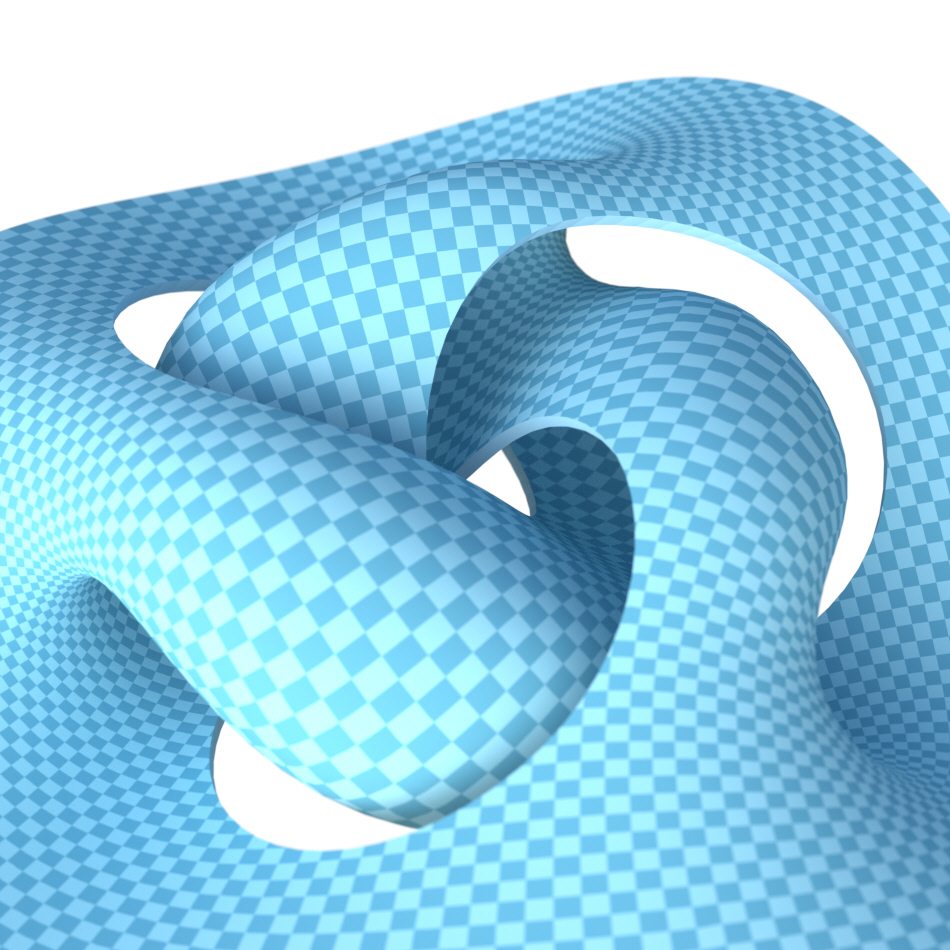
Image by Coulon, Matsumoto, Segerman & Trettel
It is impossible to “find” a mathematical idea without explaining it; exploration and exposition are two sides of the same coin. One striking example of this is the epochal work of William Thurston; often his theorems were accompanied by pictures and computer programs, illustrating the underlying ideas.
The Illustrating Mathematics Summer 2021 program took place July 19-23, virtually “at” the Park City Mathematics Institute (PCMI). It brought together mathematicians from a range of fields, and practitioners from the digital arts (animation, 3D printing, laser cutting, CNC routing, virtual reality, computer games, etc) to share their expertise in mathematics and with the procedural tools used to illustrate mathematics. Although officially a PCMI Graduate Summer School, the program was targeted both to graduate students and to mathematics community members from all backgrounds. In addition to online lectures from a variety of mathematicians and practitioners, the week consisted of several workshops to train participants in a variety of digital media (see below for a detailed schedule).
Code of Conduct
The Illustrating Math program was dedicated to creating a respectful, inclusive environment that fosters creativity and is open to a broad range of new ideas. Therefore, all participants followed a few key principles that help to establish such an environment. Of course, participants should adhere to the PCMI Code of Conduct (at the bottom of the linked page). This program adds the following items:
- Participants will avoid any inappropriate actions or statements based on individual characteristics such as age, race, ethnicity, sexual orientation, gender identity, gender expression, marital status, nationality, political affiliation, ability status, educational background, or any other characteristic protected by law.
- Disruptive or harassing behavior of any kind will not be tolerated. Harassment includes but is not limited to inappropriate or intimidating behavior and language, unwelcome jokes or comments, unwanted attention, offensive images, photography without permission, and stalking.
- Because Illustrating Math is inherently a cross-disciplinary enterprise, the prior mathematical experiences of participants encompass a very broad spectrum. Hence, discussion should avoid presuming particular in-depth prior knowledge or background, and participants must not explicitly or implicitly criticize others’ knowledge or skills or validity of others’ perspective on the effort to make mathematics more visible and comprehensible to all.
The organizers wish to thank the American Physical Society for identifying and formulating the first two principles. Although hopefully unnecessary, sanctions will result from violations of this Code of Conduct, ranging from written warnings to curtailment of meeting privileges. If you observed or were subject to breaches of this code, please contact one of the meeting ombuds, Sabetta Matsumoto or Jayadev Athreya (contact information was in your program information email from the organizers).
Program Details
Plenary Addresses
- Ingrid Daubechies (Duke University)
Visualization for research and exposition
Visualization is a powerful tool to explain and illustrate, but it can also be useful to gain understanding and insight, and to guide conceptual thinking. This talk will present some examples from the speaker’s own research career.
 Vernelle Noel (University of Florida)
Vernelle Noel (University of Florida)
The Mathematics of Wirebending
Craft practices, knowledges, and communities are disappearing. These practices carry with them histories and cultures of people, knowledges, and social ties to communities. One of these practices is wire-bending in the Trinidad Carnival, which began in the 1930s. Some reasons for its disappearance include dying practitioners, lacking pedagogy, changing practices, and technocentric developments. How might we employ mathematics in the restoration, remediation, and reconfiguration of this practice, knowledge, and community? In this talk, I share: (1) The Bailey-Derek Grammar, a mathematical description of this dying craft which has aided in documentation and transmission of this knowledge, (2) new tectonics for construction based on shape calculations and transformations, and (3) new artistic expressions and play resulting from the creation of experimental CAD software based on the culture of Carnival and wire-bending.
 Daniel Piker (Foster + Partners)
Daniel Piker (Foster + Partners)
Generating Geometry through Minimization and Play
Digital tools can enable playful generation, visualization and exploration of geometric forms. This talk will show several ways the minimization of multiple geometric energies can be applied to architecture and design.
Schedule
(All times are U.S. Mountain Daylight Time.)
| Mon, Jul 19 | Tue, Jul 20 | Wed, Jul 21 | Thu, Jul 22 | Fri, Jul 23 | |
|---|---|---|---|---|---|
| 8:30 - 9:00 | Come Say Hello: informal tech check-in | ||||
| 9:00 - 9:25 | Welcome and organizational plenary meeting | ||||
| 9:30 - 11:00 | |||||
| 11:15 - 12:30 | |||||
| 13:00 - 14:00 | Daniel Piker Generating Geometry through Minimization and Play | Vernelle Noel The Mathematics of Wirebending | Modular a participatory distributed mathematical construction (followed by informal social time) | Ingrid Daubechies Visualization for research and exposition | Workshops Present! |
| 14:15 - 15:45 | Show and Ask | Show and Ask | Community Show and Ask |
||
| 16:00 - 17:30 | |||||
Tech check-in
When convenient during this first half-hour on Monday morning, participants are encouraged to connect to the conference platform and informally say hello to the organizers. This period also provides an opportunity to ensure that the technology is working for you before the events begin.
Workshops
All participants had the opportunity to participate in one of the program’s workshops listed below. Participant/workshop matching occurred in advance. Participants presented what they created on Friday afternoon.
See the workshop page for details on your workshop, including how to prepare before the start of the course; the listings below are just very brief summaries for reference.
The workshops met daily during the program. They consisted of a 90-minute primary presentation/work session supervised by the workshop leader, followed (after a 15-minute break) by “virtual office hours” with an experienced facilitator (the workshop leader or an assistant) for optional informal small-group discussion. Note there were also virtual spaces set aside during peer collaboration time for participants to work together on workshop projects.
Blender for mathematicians: a beginner’s workshopRémi Coulon
Blender is an open source 3D graphics software, popular among digital artists for its organic virtual sculpting environment and advanced animation tools. This workshop will introduce beginners to its use for creating mathematical images.
Illustrating Mathematics with Grasshopper
Dave Bachman
Note: The first session will be held in Rémi Coulon’s Blender Zoom room. Grasshopper is a visual scripting platform for Rhino 3D. Participants in this workshop will learn the basics of mathematical model building with Grasshopper.
Traditional CAD/CAM Software for Mathematical Models
Glen Whitney
Note: The first session will be held in Edmund Harriss’ CNC Toolpaths Zoom room. This tutorial provides an introduction to traditional CAD/CAM drawing tools, a class of software that may be unfamiliar to many in the mathematics and mathematical illustration community. Participants should complete the workshop preparation before the beginning of the course.
Mathematical CNC Toolpaths
Edmund Harriss
CNC (Computer Numerical Control) machining has a rather high barrier to entry, but has a lot of mathematical potential. Participants will get to create lines and paths and see the effects when these get cut into wood.
Drawing Julia Sets
Arnaud Chéritat
We will review techniques for drawing Julia sets, dating from the 80s through recently developed tricks. Participants should complete the workshop preparation before it begins.
Graphic Novels Can Teach Mathematics
Audrey Nasar
In the United States, graphic novels are increasingly being used for scholastic purposes across the curriculum as supplements or replacements for traditional textbooks. In this workshop, participants will explore using this format for lessons of their own devising.
Visualizing Mathematical Structures with Processing
Roger Antonsen
We explore how mathematical structures, in particular discrete structures and sets of finite objects, can be visualized, and interactively experimented with, in the Processing graphics environment.
Interactive Videos for Teaching and Visualization
Yuri Sulyma
Participants will learn to create videos that viewers can manipulate/interact with, with a focus on mathematical content.
Show and Ask
In the spirit of what’s known in American culture as “Show and Tell,” these sessions allowed many participants a few minutes to say a bit about themselves and what their interests in illustrating mathematics are. Each participant could display and describe a math-related image, object, video, audio recording, or other form of illustration, particularly one that is a work in progress, and ask the collected participants something they may be wondering about the illustration: how to improve it, how to solve some problem related to it, how to connect with others who might be interested, etc.
The Monday and Tuesday sessions were reserved for registered participants in the Illustrating Math week to help attendees get to know each other and become familiar with others’ efforts in this area. There was an opportunity to sign up in advance, and any participant who wishes to display something and say a few words about it had an opportunity. During the Thursday session, we will also welcomed some members of the broader Illustrating Mathematics community to present, so that participants could become more familiar with the
range of efforts and inquiry going on in this field.
Peer collaboration time
Time was set aside in the schedule each day for peer collaboration. During this time, there were virtual spaces set aside dedicated to each workshop (without the presence of the workshop leader or assistants), as well as for general discussion on illustrating math topics. Participants used this time to work together on workshop projects, initiate their own efforts to illustrate math together, or simply get to know each other better.